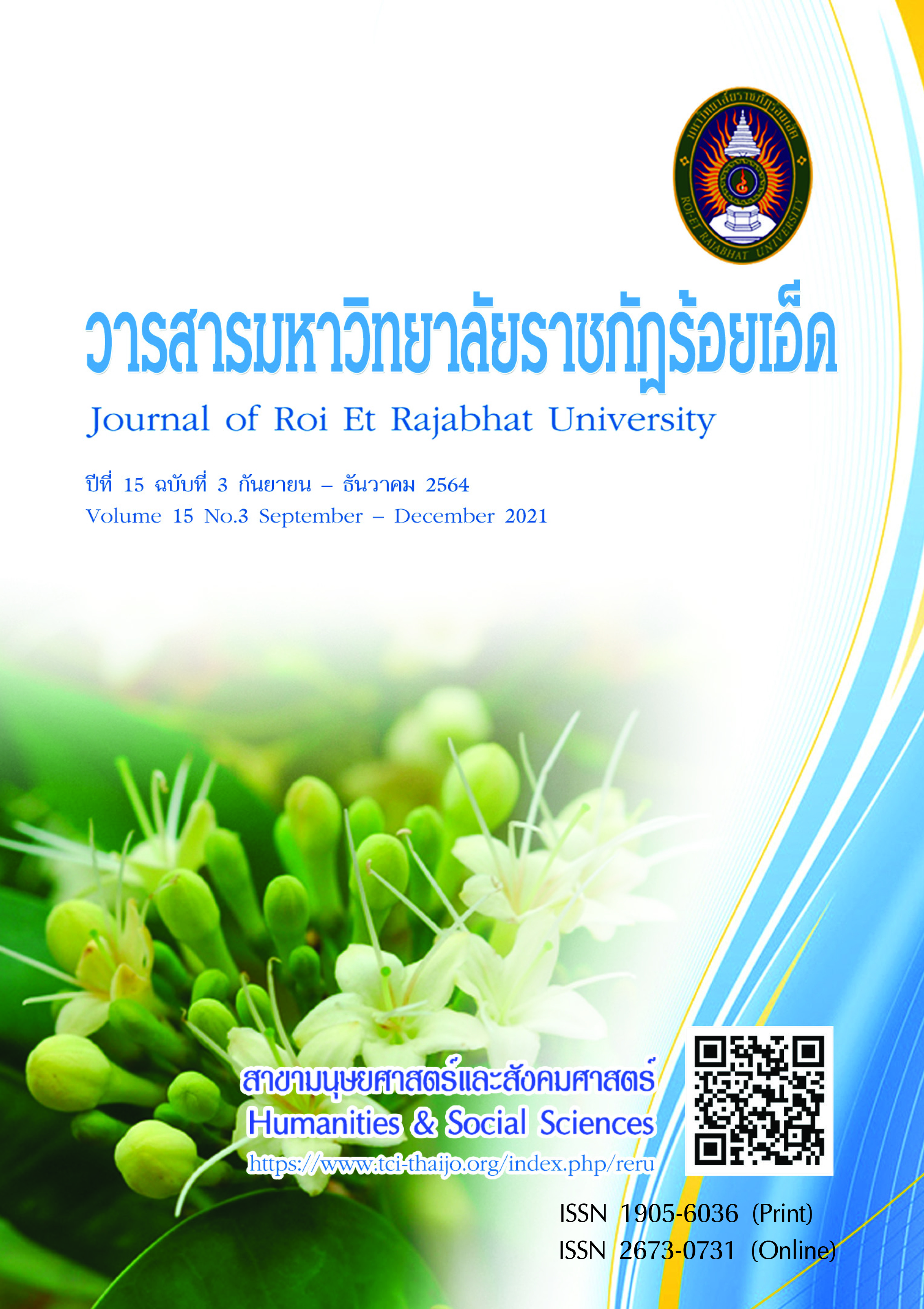The Study of Characters’ Behaviors using Psychoanalytic Theories of Sigmund Freud in a Songnaree Novel by Phatcha
Keywords:
Behaviors of Main Characters, Psychoanalytic Theory, Songnare NovelsAbstract
The objective of this research was to analyze behaviors of 4 characters which were Panithee, Panithi, Art and Sant in the Songnaree novel of Phatcha. The research applied Sigmund Freud's psychoanalytic theory as a framework for behavior analysis and presented the results by descriptive analysis. The results of character analysis revealed that Panithee's behaviors included sexually addictive behavior, jealousy, gratefulness, speak reasonably for others to trust, act as a good person, need money and things, aggressive, afraid of revealing secrets, fear of guilt, repression, displacement, projection and reaction formation. Expressed behaviors of Panith were sad, shy, love reserved, gratefulness of benefactors, self-willed, verbal aggression, avoidance, sympathize with others, dependence on others, aggressive, afraid of attack, afraid of accepting new things, repression, projection and sue. While expressed behaviors of Art were not a gentleman, restrain oneself, love fairness, not careful with words, pride, responding to sexual impulses, aggressive, afraid of becoming infected with HIV, displacement ant sham. Finally, behaviors of Sant were unfaithful, restrain oneself, remorseful, retaliation, irritability, annoyance. honest to your lover, retaliation, irritable and annoyed, honest with lover, being worried about other people, responding to sexual impulses, verbal aggression, afraid of becoming infected with HIV, fear of guilt, displacement, projection and sham.
References
กาญจนา วิชญาปกรณ์. (2542). ทฤษฎีวรรณคดี. พิษณุโลก: มหาวิทยาลัยนเรศวร.
กิติกร มีทรัพย์. (2554). วิสิฏฐีฉบับจิตวิเคราะห์. กรุงเทพฯ: ปราชญาพับลิชชิ่ง.
จารวี บัวขม. (2558). โครงสร้าง บุคลิกภาพและคุณค่าต่อสังคมในนวนิยายของกิ่งฉัตร. วิทยานิพนธ์ ศิลปศาสตรมหาบัณฑิต สาขาวิชาภาษาไทย. เชียงใหม่: มหาวิทยาลัยราชภัฏเชียงใหม่.
ชำนาญ รอดเหตุภัย. (2552). การวิจัยทางภาษาไทย. กรุงเทพฯ: จุฬาลงกรณ์มหาวิทยาลัย.
ประมูล บุญปก. (2560). ความซับซ้อนของบุคลิกภาพตัวละครเอกจากนวนิยายโบตั๋นในห้าทศวรรษ. วิทยานิพนธ์ ศิลปศาสตรมหาบัณฑิต สาขาวิชาภาษาและวรรณกรรมไทย. มหาสารคาม: มหาวิทยาลัยราชภัฏมหาสารคาม.
พวงพยอม ชิดทอง. (2549). จิตวิทยาบุคลิกภาพ. เชียงใหม่: มหาวิทยาลัยราชภัฏเชียงใหม่.
พัดชา. (นามปากกา). (2559). สองนรี. กรุงเทพฯ: ศิลปาบรรณาคาร.
ลินจง จันทรวราทิพย์. (2548). วรรณกรรมวิจารณ์. นครปฐม: มหาวิทยาลัยราชภัฏนครปฐม.
อุไรวรรณ สิงห์ทอง, หนึ่งฤทัย ม่วงเย็น, เชอร์รี่ เกษมสุขสำราญ, แสงระวี ทวีรัตน์, จักรกฤษณ์ อู่ตุ้ม และรัศมี ราชบุรี. (2561). การวิเคราะห์พฤติกรรมด้านมืดของตัวละครที่ปรากฏในนวนิยายเรื่อง บ่วงหงส์ ของกิ่งฉัตร. รายงานสืบเนื่องจากการประชุมวิชาการระดับชาติและนานาชาติ ครั้งที่ 2 พ.ศ. 2561. 1 กุมภาพันธ์ 2561. บุรีรัมย์: มหาวิทยาลัยราชภัฏบุรีรัมย์. 1028-1037
TV Digital watch. (2562). 10 อันดับเรตติ้งสูงสุดในช่วงไพรม์ไทม์ (20:30-22:30) ประจำวันที่ 7 ตุลาคม 2562. สืบค้นเมื่อ 23 มีนาคม 2563, จาก https://www.tvdigitalwatch.com
Freud, S. (1964). Group Psychology and The Analysis of the Ego Sigmund Freud. New York: Bantam Books.
Downloads
Published
How to Cite
Issue
Section
License
บทความที่ได้รับการตีพิมพ์เป็นลิขสิทธิ์ของวารสารมหาวิทยาลัยราชภัฎร้อยเอ็ด
ข้อความที่ปรากฏในบทความแต่ละเรื่องในวารสารวิชาการเล่มนี้เป็นความคิดเห็นส่วนตัวของผู้เขียนแต่ละท่านไม่เกี่ยวข้องกับมหาวิทยาลัยราชภัฎร้อยเอ็ด และคณาจารย์ท่านอื่นๆในมหาวิทยาลัยฯ แต่อย่างใด ความรับผิดชอบองค์ประกอบทั้งหมดของบทความแต่ละเรื่องเป็นของผู้เขียนแต่ละท่าน หากมีความผิดพลาดใดๆ ผู้เขียนแต่ละท่านจะรับผิดชอบบทความของตนเองแต่ผู้เดียว





